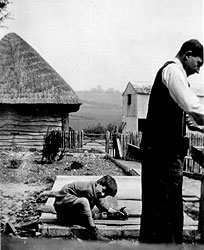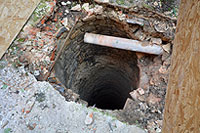

| Mains water didn’t arrive in the village until the 1930s, until then the village depended on individual wells, many of which continued in use after the pipes were laid. Thisextract shows the various wells in this part of Lower Froyle as shown on the 1910 Ordnance Survey map. | ||||
 |
||||

|
The well at “Hodges Farm”, (top left), can be seen in this family photograph from 1935, which, as far as we know, shows restoration work on the top of the well. A lot of the wells were actually inside the cottages (see Bill Elstow’s memories below) and, as a result, are not shown on the map. |
|||
 |
  |
An example of this is the well at “Warren Cottage” which is situated in between the two halves of the building (marked with a blue cross on the plan). The lower picture gives an idea of the brick lining at the surface which goes down about five feet into the chalk. We lowered a plumb line into the hole and it stopped at abour 50 feet down. Needless to say the well has now been capped with concrete! (Thanks to Gillian & Jonathan Pickering, the owners, for letting us take the pictures) |
||
Bill Elstow remembers the wells in Froyle cottages:- |
||||
“Drawing water from a well is an interesting
experience if you have not done it before. At the first cottage that
my Grandmother lived in (Church Cottage, right) the well was
in the garden, in the second it was in the scullery of the attached
cottage. Thus this backdoor always had to be left unlocked to provide
access but as the front door of most cottages could be opened during
the day by just lifting a latch this was nothing remarkable. Neither
well was like the traditional representation of a well with a low
surrounding wall. They were both round holes about 4 to 5 foot across
in a one brick high plinth. When not in use the hole was covered by
two wooden doors meeting at the middle. The doors may well have been
the two hundred year old originals, they certainly would not have
borne anybody weight. The winding axle was a smooth log shaped piece
of wood with an iron crank handle at one end.
To draw water you clipped your bucket to the end of the wire rope leaned forward, opened the doors and let the bucket fall by its own weight. As it picked up speed and approached the water, (gran’s was reputed to be an extra deep well), you slowed its descent by resting your hand on the smooth winding axle but at all times keeping clear of the flailing, arm breaking, wrist smashing, iron crank handle. Then came the long wind up and finally the lean forward over the hole to pull the bucket to the side to unhook it. At this point if you were careless it was possible to drop the bucket down the well. Fortunately there were ‘experts’ in the village who would then come along with a grappling hook and drag about for sometime, making remarks such as “Its enormous down there, you could get a cart and horses in it”. They very seldom recovered a bucket from gran’s well, it was too deep, though they frequently brought up remnants of much older buckets. A proper well bucket was shaped narrow at the top and bottom and wide in the middle like a plumb bob. It was much easier to draw up than a wide mouth bucket that would tend to sway. However it was much more expensive and the risk of losing it could not be contemplated. The sides of the well were constructed of chalk bricks all green and damp at the top and covered in cobwebs. Presumably all this debris joined the rusty buckets at the bottom of the well but I don’t recall anybody considering this when drinking the water. All in all the whole process would be a modern Health and Safety Officers delight.” |
||||